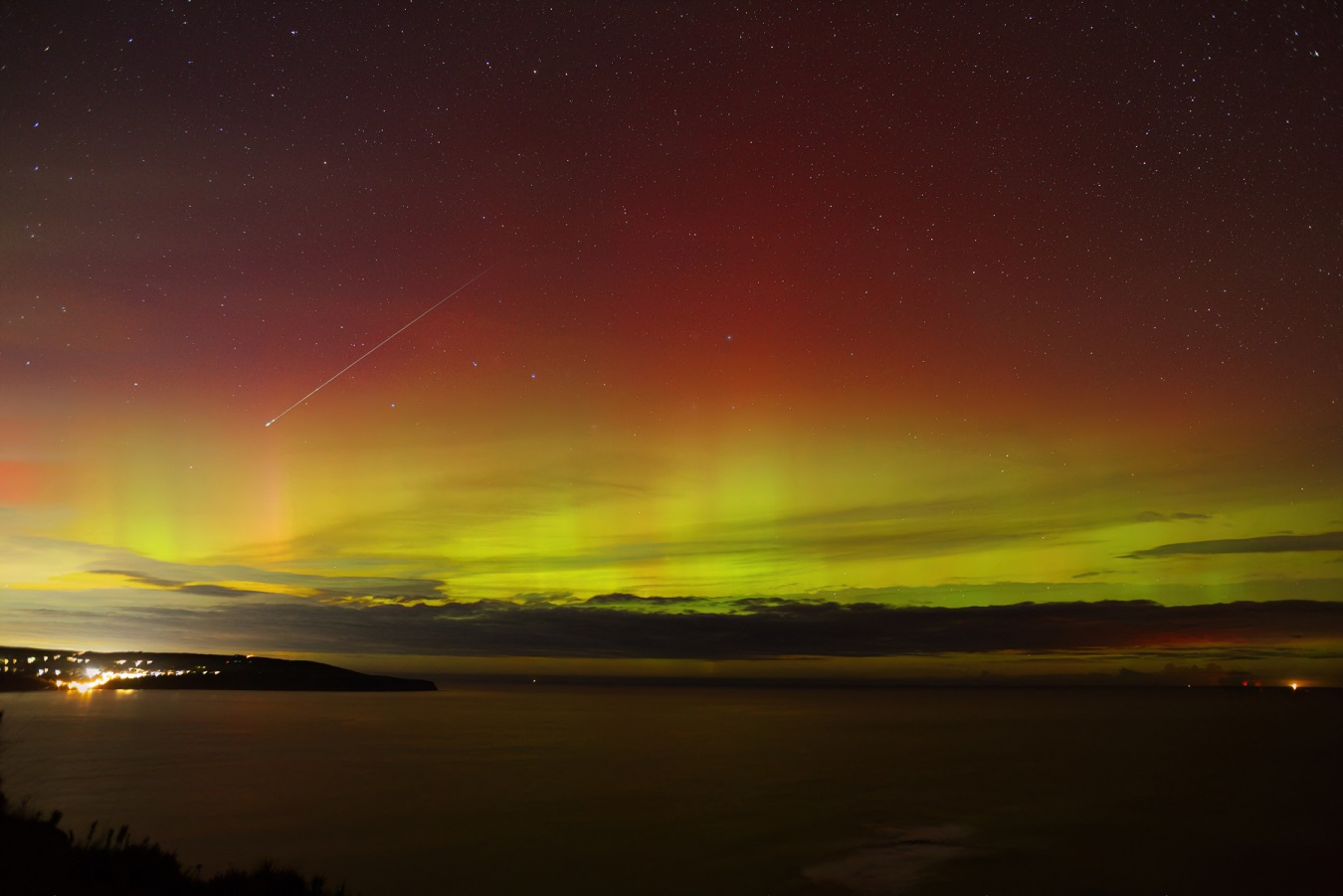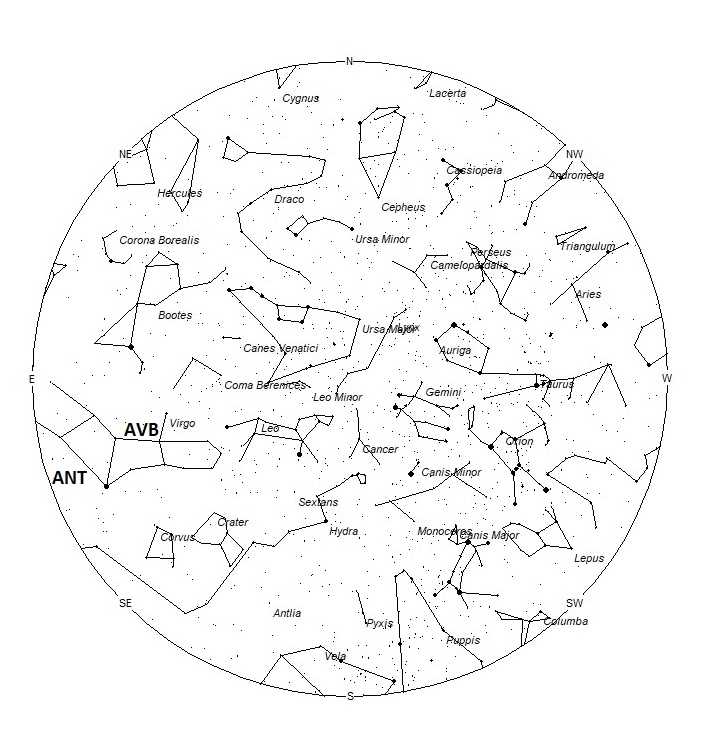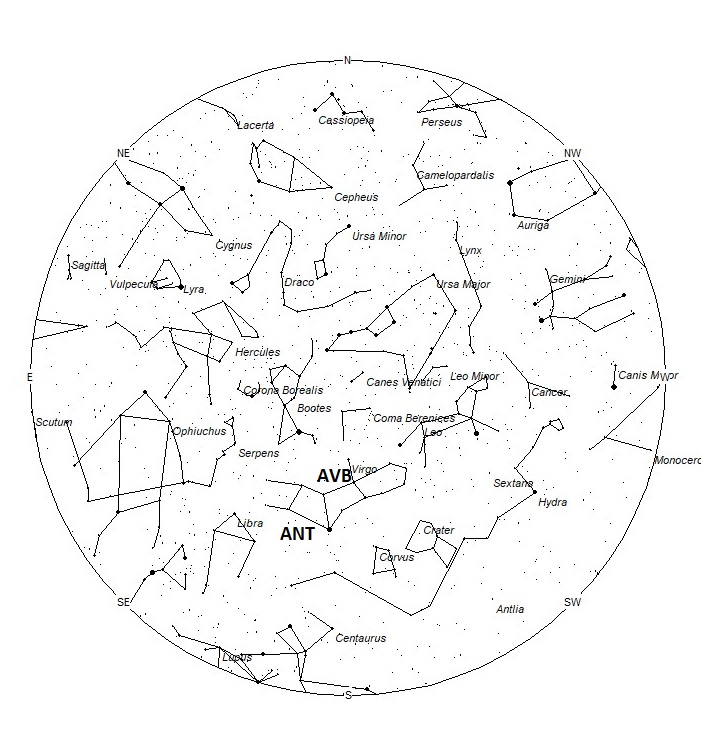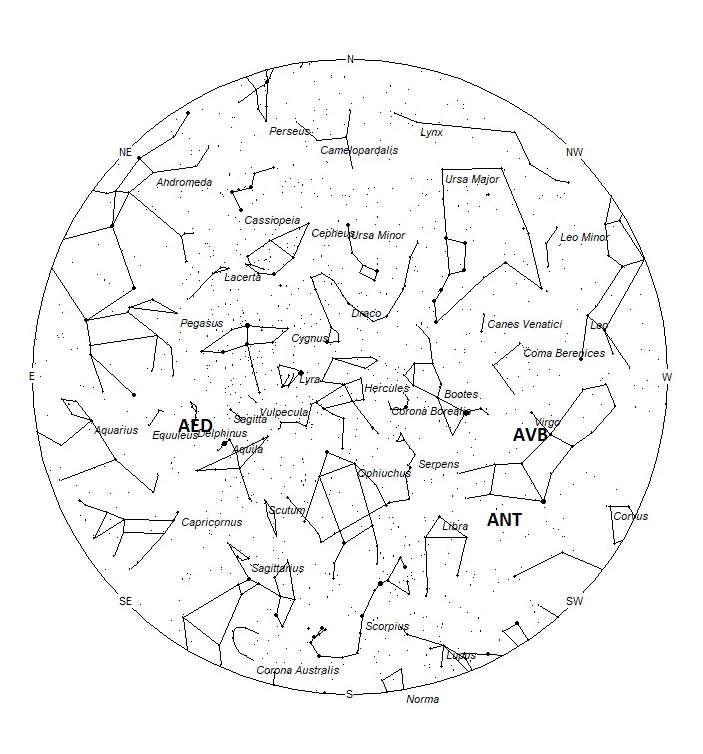
During this period, the moon reaches its new phase on Monday April 8th. At that time, the moon will be located near the sun and will not be visible during nighttime hours. As the week progresses the waxing crescent moon will enter the evening sky but will be too thin to interfere with meteor observing. The estimated total hourly rates for evening observers this weekend should be near 3 as seen from mid-northern latitudes (45N) and 4 as seen from tropical southern locations (25S) For morning observers, the estimated total hourly rates should be near 7 as seen from mid-northern latitudes (45N) and 10 as seen from tropical southern locations (25S). The actual rates seen will also depend on factors such as personal light and motion perception, local weather conditions, alertness, and experience in watching meteor activity. Note that the hourly rates listed below are estimates as viewed from dark sky sites away from urban light sources. Observers viewing from urban areas will see less activity as only the brighter meteors will be visible from such locations.
The radiant (the area of the sky where meteors appear to shoot from) positions and rates listed below are exact for Saturday night/Sunday morning April 6/7. These positions do not change greatly day to day so the listed coordinates may be used during this entire period. Most star atlases (available at science stores and planetariums) will provide maps with grid lines of the celestial coordinates so that you may find out exactly where these positions are located in the sky. I have also included charts of the sky that display the radiant positions for evening, midnight, and morning. The center of each chart is the sky directly overhead at the appropriate hour. These charts are oriented for facing south but can be used for any direction by rotating the charts to the desired direction. A planisphere or computer planetarium program is also useful in showing the sky at any time of night on any date of the year. Activity from each radiant is best seen when it is positioned highest in the sky, either due north or south along the meridian, depending on your latitude. Radiants that rise after midnight will not reach their highest point in the sky until daylight. For these radiants, it is best to view them during the last few hours before dawn. It must be remembered that meteor activity is rarely seen at its radiant position. Rather they shoot outwards from the radiant, so it is best to center your field of view so that the radiant lies toward the edge and not the center. Viewing there will allow you to easily trace the path of each meteor back to the radiant (if it is a shower member) or in another direction if it is sporadic. Meteor activity is not seen from radiants that are located far below the horizon. The positions below are listed in a west to east manner in order of right ascension (celestial longitude). The positions listed first are located further west therefore are accessible earlier in the night while those listed further down the list rise later in the night.
These sources of meteoric activity are expected to be active this week
.
The alpha Virginids (AVB) were first mentioned by R. B. Southworth and G. S. Hawkins in their publication known as Smithsonian Contributions to Astrophysics (1963). These meteors are active from April 6 through May 1 with maximum occurring on April 18th. The current location of this radiant is 13:03 (196) +04. This position is located in central Virgo, 2 degrees northeast of the 3rd magnitude star known as Minelauva (delta Virginis). This radiant is best placed near 01:00 local daylight-saving time (LDST) when it lies on the meridian and is highest in the southern sky. Rates at this time should be less than 1 per hour no matter your location. With an entry velocity of 21 km/sec., the average meteor from this source would be of very slow velocity. This source is far enough from the core of the anthelion radiant to be noticed but care must be taken to differentiate between the two radiants.
The large Anthelion (ANT) radiant is currently centered at 14:00 (210) -10. This position lies in southeastern Virgo, 10 degrees southeast of the 1st magnitude star known as Spica (alpha Virginis). Due to the large size of this radiant, these meteors may also be seen from western Libra as well as eastern Virgo. This radiant is best placed near 02:00 LST when it lies on the meridian and is highest in the southern sky. Rates at this time should be near 2 per hour as seen from the northern hemisphere and 3 per hour as seen from south of the equator. With an entry velocity of 30 km/sec., the average Anthelion meteor would be of slow velocity.
The April epsilon Delphinids (AED) were discovered by P. Jenniskens and R. Rudawska from CAMS and SonotaCo meteoroid orbit surveys published in 2014.This weak source is active from March 31 through April 20, with maximum activity occurring on April 9th. The radiant currently lies at 20:24 (306) +11. This position lies in southern Delphinus, 2 degrees southwest of the 4th magnitude star known as Aldulfin (epsilon Delphini). With an entry velocity of 61km/sec., the average meteor from this source would be of fast velocity. These meteors are best seen during the last dark hour prior to morning twilight when the radiant lies highest in the eastern sky. Current hourly rates are expected to be less than 1.
The delta Pavonids (DPA) were discovered by Michael Buhagiar from Australia in the 1970’s. These meteors are active from March 11 through April 16, with maximum activity occurring on March 30th. The current position of the radiant lies near 21:24 (321) -65. This area of the sky lies in eastern Pavo, near the spot occupied by the 4th magnitude star known as gamma Pavonis. These meteors are best seen during the last dark hour prior to dawn when the radiant lies in the southeastern sky. With an entry velocity of 58km/sec., the average meteor from this source would be of fast velocity. Expected rates are less than 1 per hour during this period. These meteors are poorly seen from the northern hemisphere.
Sporadic meteors are those meteors that cannot be associated with any known meteor shower. All meteor showers are evolving and disperse over time to the point where they are no longer recognizable. Away from the peaks of the major annual showers, these sporadic meteors make up the bulk of the activity seen each night. As seen from the mid-northern hemisphere (45N) one would expect to see during this period approximately 5 sporadic meteors per hour during the last hour before dawn as seen from rural observing sites. Evening rates would be near 2 per hour. As seen from the tropical southern latitudes (25S), morning rates would be near 8 per hour as seen from rural observing sites and 3 per hour during the evening hours. Locations between these two extremes would see activity between these listed figures. Morning rates are reduced during this period due to moonlight.
The list below offers the information in tabular form of the showers that I feel are within reach of the visual observer to discern. Hourly rates are often less than one, so these sources are rarely listed as visual targets in most meteor shower lists. If you are like me though and wish to associate as many meteors as possible with known sources, then you will appreciate these listings. Before listing meteors from these obscure sources, you should attempt to prove these meteors belong to them and are not chance alignments of sporadic meteors. You can note parameters such as duration, length, radiant distance and the elevation of each meteor to help compute the probability of shower association. It should be remembered that slow meteors can be seen from fast showers, but fast meteors cannot be produced from slow showers. Slower showers are those with velocities less than 35/km per second. Slow meteors can appear from fast showers when they appear close to the radiant or low in the sky. The table located on page 22 of the IMO’s 2024 Meteor Shower Calendar is a big help in aiding in the identification of meteors. If you record the length and duration of each meteor, you can use this chart to check the probability of the meteor belonging to a shower of known velocity. If the angular velocity is similar to the figure in the table, then your meteor probably belongs to that shower. Rates and positions are exact for Saturday night/Sunday morning.
| SHOWER | DATE OF MAXIMUM ACTIVITY | CELESTIAL POSITION | ENTRY VELOCITY | CULMINATION | HOURLY RATE | CLASS |
| RA (RA in Deg.) DEC | Km/Sec | Local Daylight-Saving Time | North-South | |||
| alpha Virginids (AVB) | Apr 18 | 13:03 (196) +04 | 21 | 01:00 | <1 – <1 | IV |
| Anthelions (ANT) | – | 13:32 (203) -10 | 30 | 02:00 | 2 – 3 | II |
| April epsilon Delphinids (AED) | Apr 09 | 20:24 (306) +11 | 61 | 09:00 | <1 – <1 | IV |
| delta Pavonids (DPA) | Mar 30 | 21:24 (321) -65 | 58 | 10:00 | ? | III |
You can keep track of the activity of these meteor showers as well as those beyond the limits of visual observing by visiting the NASA Meteor Shower Portal. You can move the sky globe to see different areas of the sky. Colored dots indicate shower meteors while white dots indicate sporadic (random) activity. The large orange disk indicates the position of the sun so little activity will be seen in that area of the sky.
Class Explanation: A scale to group meteor showers by their intensity:
- Class I: the strongest annual showers with Zenith Hourly Rates normally ten or better.
- Class II: reliable minor showers with ZHR’s normally two to ten.
- Class III: showers that do not provide annual activity. These showers are rarely active yet have the potential to produce a major display on occasion.
- Class IV: weak minor showers with ZHR’s rarely exceeding two. The study of these showers is best left to experienced observers who use plotting and angular velocity estimates to determine shower association. These weak showers are also good targets for video and photographic work. Observers with less experience are urged to limit their shower associations to showers with a rating of I to III.
 American Meteor Society
American Meteor Society



A fallen star in Nolanville, Texas April 7 2024 8:30pm
Hello, after reading this amazing paragraph i am also delighted
to share my experience here with mates.